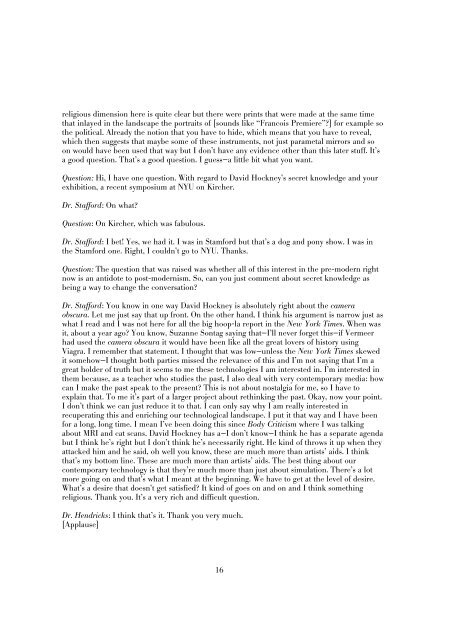SECTION 1 - via - School of Visual Arts
SECTION 1 - via - School of Visual Arts
SECTION 1 - via - School of Visual Arts
Create successful ePaper yourself
Turn your PDF publications into a flip-book with our unique Google optimized e-Paper software.
eligious dimension here is quite clear but there were prints that were made at the same time<br />
that inlayed in the landscape the portraits <strong>of</strong> [sounds like “Francois Premiere”?] for example so<br />
the political. Already the notion that you have to hide, which means that you have to reveal,<br />
which then suggests that maybe some <strong>of</strong> these instruments, not just parametal mirrors and so<br />
on would have been used that way but I don’t have any evidence other than this later stuff. It’s<br />
a good question. That’s a good question. I guess—a little bit what you want.<br />
Question: Hi, I have one question. With regard to David Hockney’s secret knowledge and your<br />
exhibition, a recent symposium at NYU on Kircher.<br />
Dr. Stafford: On what?<br />
Question: On Kircher, which was fabulous.<br />
Dr. Stafford: I bet! Yes, we had it. I was in Stamford but that’s a dog and pony show. I was in<br />
the Stamford one. Right, I couldn’t go to NYU. Thanks.<br />
Question: The question that was raised was whether all <strong>of</strong> this interest in the pre-modern right<br />
now is an antidote to post-modernism. So, can you just comment about secret knowledge as<br />
being a way to change the conversation?<br />
Dr. Stafford: You know in one way David Hockney is absolutely right about the camera<br />
obscura. Let me just say that up front. On the other hand, I think his argument is narrow just as<br />
what I read and I was not here for all the big hoop-la report in the New York Times. When was<br />
it, about a year ago? You know, Suzanne Sontag saying that—I’ll never forget this—if Vermeer<br />
had used the camera obscura it would have been like all the great lovers <strong>of</strong> history using<br />
Viagra. I remember that statement. I thought that was low—unless the New York Times skewed<br />
it somehow—I thought both parties missed the relevance <strong>of</strong> this and I’m not saying that I’m a<br />
great holder <strong>of</strong> truth but it seems to me these technologies I am interested in. I’m interested in<br />
them because, as a teacher who studies the past, I also deal with very contemporary media: how<br />
can I make the past speak to the present? This is not about nostalgia for me, so I have to<br />
explain that. To me it’s part <strong>of</strong> a larger project about rethinking the past. Okay, now your point.<br />
I don’t think we can just reduce it to that. I can only say why I am really interested in<br />
recuperating this and enriching our technological landscape. I put it that way and I have been<br />
for a long, long time. I mean I’ve been doing this since Body Criticism where I was talking<br />
about MRI and cat scans. David Hockney has a—I don’t know—I think he has a separate agenda<br />
but I think he’s right but I don’t think he’s necessarily right. He kind <strong>of</strong> throws it up when they<br />
attacked him and he said, oh well you know, these are much more than artists’ aids. I think<br />
that’s my bottom line. These are much more than artists’ aids. The best thing about our<br />
contemporary technology is that they’re much more than just about simulation. There’s a lot<br />
more going on and that’s what I meant at the beginning. We have to get at the level <strong>of</strong> desire.<br />
What’s a desire that doesn’t get satisfied? It kind <strong>of</strong> goes on and on and I think something<br />
religious. Thank you. It’s a very rich and difficult question.<br />
Dr. Hendricks: I think that’s it. Thank you very much.<br />
[Applause]<br />
16








